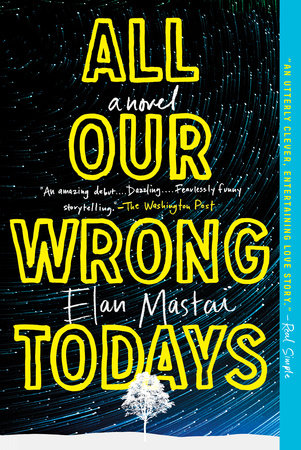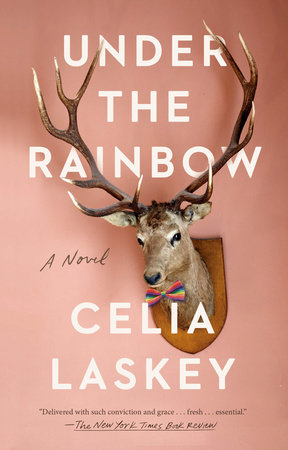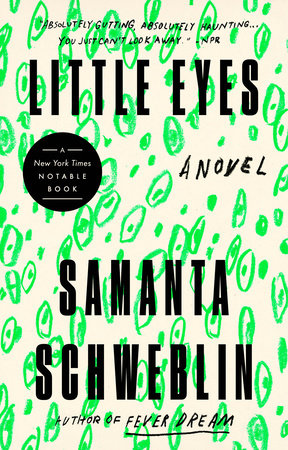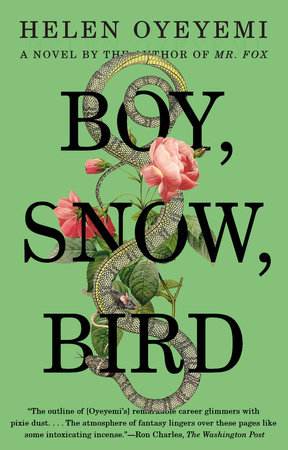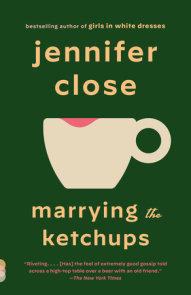Author Q&A
Q: This is such an unusual story—where did you get the idea for it?
A: It started as a joke. It happened because one summer day in 1979 my eight-year-old son flatly refused to go along on my favorite walk up the hills to the rose test garden in the park. I went alone, sulking, and wound up perched on a brick step glaring at the experimental roses.
The nature vs nurture debate had fascinated me for years. The potential for revelations and manipulations rising from the study of genetics was a topic for frequent and gleeful speculation over late night cocoa in my kitchen. That day the ornate roses set me thinking again about the possibility of deliberately monkeying with human DNA to breed desirable traits in our progeny as the plant folk did with these flowers. The notion always held a chilling element for me—what if human character were completely determined by genetics and physiology so that science might eventually eradicate the mystery of personality? If humans were as predictable as chemical reactions, where would stories go? Or come from?
Generally I am from the “All of the Above” school. I figure humans are far too complicated and touchy to be the product of any one line of influence, no matter how powerful. Still, in pouty moods the “what ifs” can get to me. That day they torpedoed the future of all literature by my dim lights. At least, I consoled myself sourly, I could design a more obedient child.
The sudden image of that feral and argumentative creature, my son, bovined to docility struck me as hilarious. “Whatever you say, Mom. Right away, Mom.” Never going to happen and no, I would never swap my cougar cub for some blandly compliant herbivore.
This realization brightened my mood so much that I fell to playing in my head. I can’t recall precisely after all these years, but my hypothesizing certainly ran along lines like this:
• Say dramatic manipulation of DNA in utero or before conception actually became possible.
• There would be fashions and fads. You would know a person’s vintage by their complexion, stature, and I.Q. “Oh yeah, she’s from the 2040s. That was the era of arched Pontiac noses, curly hair, an easy grasp of higher mathematics, but marginal social skills.” Or, “Can you believe the small feet they’re giving kids these days? Don’t tell me the shoe companies aren’t pushing that style. You notice the prices haven’t gone down despite the money they’re saving in materials. . . .”
• Infants would emerge from the womb with designer labels in birthmarks on the napes of their necks. Design wars would flare over chin clefts and buttock dimples. Cheap discount versions would all come out with the same fingerprints or a tendency, which would only appear long after the warranty had expired, to wear plaid pants.
• Naturally, everybody would want their children strong, resistant to disease, and cheerful of temperament. But governments would impose uniform “safety” requirements—all citizens must be placid, gullible, reverent to authority, and willing to stand in lines. A vision of marching rows of tall, clear-eyed blondes reminded me that totalitarian regimes had already tried this kind of bio-social engineering with hideous results. But that was before sufficient technology was available.
Perfection is boring, but that would be the alleged aim. So . . . Who would want something more interesting? The answer was simple and inevitable. A carnival, of course. A freak show. In that context the more unusual you are, the more valuable you are. It would reverse the view. This struck me as enormously exciting fun.
Having moped up the hill, I was almost bouncing on the way down.
By the time I made it to the pens and paper on my work table, it had occurred to me that the compounded isolation created by physical differences and the rootless traveling of an old-fashioned circus carnival made it prime turf for a cult. The cult phenomenon had occupied my nightmares since the Jonestown massacre in Guyana. Here was a way to explore that monster from other angles. Then too, any group of people in extended proximity develop alliances and rivalries, power struggles and intense emotional connections, which opens all those doors. . . .
It began as a joke. When a joke is prodded and stretched and you climb inside and walk around, it changes. When I started to think about what it would actually be like to be a member of the Binewski clan, the Binewskis became real for me. The book took many years to write because it took me that long to imagine it all—to live it. Sometimes I thought of it as my own private autism, the place out at the far end of the shock wave when my brain exploded.
Q: The epigraph, the chapter titles, and the strange names of the family all seem connected. What do they signify?
A: All these items are meant to carry a tone of flickering levity—dark, dry or bumptious depending on where they occur.
The Epigraph:
For my own pleasure and convenience during the writing, the main characters each had a theme song, of sorts. Something for me to remember them by. Something that seemed to pinpoint their essential identity for me. For example, Olympia and Chick were announced in my head by quotations from the poems of William Blake. For Chick it was, “If the child is born a boy/ he’s given to a woman old/ Who nails him down upon a rock/ and catches his shrieks in cups of gold.” Oly’s was, “Little creature/ born of joy and mirth/ go love without the help/ of anything on earth.”
Arturo’s sign post was from Shakespeare’s play “The Tempest.” The old magician, Prospero, is accepting responsibility for the demonic imp Caliban when he says, “This thing, of darkness I Acknowledge, mine.”
When the book was finished I realized that Arty’s theme belonged to the whole book, so I set it there at the beginning.
The Chapter Titles:
The old picaresque novels use the convention of the chapter title—in part perhaps because so many of them ran serially in newspapers and the titles served as headlines. . . . “In Which Our Hero Loses That Which He Can Scarcely Spare . . . ” or “Our Hero, Bolting, Comes a Cropper.” I love that kind of fun and it seemed appropriate for this book. The titles serve many purposes. They are clues to the contents, commentaries on the action, and tone setters. Most of them are meant to be sardonically humorous, reminding the reader that no matter how dark the coming passages may be, the soothing light of absurdity will show the way.
The Family Names:
Sometimes naming fictional characters is a lot like naming real babies. You come up with a name before you know much about them as individuals. You pick a name that represents an idea of what you want them to be.
I wanted the carnival family to be a classic all-American mix, rootless originals spliced into something new. The name Binewski was part of a rhyming pet name my mother used to call us kids when we were growing up. “Now, my little Rooski Binooski,” she’d say. It has a nice middle-European rhythm. Aloysius (which I pronounce “allo-wishes”) is a stereotypical Irish name. Lillian Hinchcliff is the snooty WASP/English contingent. The children have Greek or Italian names, partly to suggest a kind of ostentation by the parents, and partly for the lyric bombast native to the show world of carnivals and circuses.
Arturo suggests artifice. His man-made quality, along with deception.
Fortunato, meaning Lucky, is ironical considering what happens to the poor little bug. He’s called Chick, a fuzzy, vulnerable newborn thing.
Electra and Iphigenia are the two daughters of King Agamemnon in the Greek tragedies. The king slaughters Iphigenia in sacrifice to the gods to gain a fair wind for his ships to sail to the Trojan war. Electra later helps her brother wreak revenge on her father’s murderers.
Olympia is the high, cool mountain home of the Greek gods. It is also the name of a cheap, watery beer commonly known as Oly.
Q: What kind of research did you do for this book?
A: Over a medium lifetime I’d known several people who were disabled or who were configured in original ways. I thought about them a lot. Of course I’d seen Tod Browning’s film, Freaks, and I’ve heard of the film, Nightmare Alley but have not yet seen it. I did a lot of clinical reading on two basic topics: physical anomaly and cults of various kinds. Some of Arturo’s speeches are modeled on the rambling sermons of Jim Jones to his followers in Guyana during the weeks leading up to the mass murder/suicide. I’ve always loved circuses and carnivals, and I took every chance that came my way to hang around midways, sniffing and snooping.
Q: Inside its highly imaginative storyline, GEEK LOVE takes on some pretty heavy issues such as our concepts of beauty, organized religion, and capitalistic greed, among others. Were you aiming to make a statement with this book?
A: Certainly. I intended to make a lot of statements, which is why it took all those pages. If I’d only had one thing to rant about I could have put it in a letter to the editor.
One thing that fascinates me is the variety of ways people have read the book. A writer for a parenting publication saw it as an exposé of the way American parents exploit and abuse their children. A former fashion writer saw it as an indictment of shallow concepts of beauty. A writer for a newsletter for the disabled declared she couldn’t decide whether it was the best thing for disability rights ever to come down the pike or one long, ghastly crip joke. Gay men and women have described it as a metaphor for all outsiders. Of course I’m only mentioning positive stuff. The point is, everybody reads a different book. That’s more than fine with me.
Q: GEEK LOVE inspired some pretty strong reaction upon its publication in 1989, mostly criticism for its controversial subject matter. What did/do you think about this reaction?
A: When you’re immersed in a world for years at a time it comes to seem normal. It’s easy to lose track of how other people might view it. While there were some positive reviews, there were also virulent attacks. At first I was surprised at the fuss. And I was embarrassed and sorry that my editor and even some bookstores took flack about it. But I was also pleased. I’d hoped it was not a safe or easy book. It challenged me in the writing, and I hoped it would challenge readers. At least nobody that I heard about was calling it boring. I thought some of the criticism was silly. Some was cogent but I, of course, disagreed. No book appeals to everybody.
I did feel bad for the Polish Anti-Defamation League, which interpreted the entire book as a slur against people of Polish descent because of the family name, Binewski. That was never my intention. Not for an instant.
Q: The book has achieved a kind of cult status among your readers. What do you think of this? Do you still hear from people about the book?
A: Yes, I’m grateful that readers do still write to me and they’re not all furious. Some members of the Little People of America have been generous with supportive comments. That means a lot to me. Then there are the stump fetishists, amputation lovers, whom many view as mere party animals, but who are, in my experience, remarkably sensitive with just a tad more flair than is customary in the mainstream.
Some artists have used the book as a launching pad for their own work, and that astounds and delights me. Painters and photographers have done marvelous visual images of characters and incidents from the book, or fresh stuff inspired by it. A few musicians have written songs. One talented group of theater people in Chicago wrote and staged a tough, smart, funny operetta a year or so ago and they’re talking about doing it again in Los Angeles. There have been several other stage productions and public readings. It’s such a kick when people do this. They arc off into wild directions that are completely their own but if they choose to claim the Geek as their trampoline, it gives me what I suppose is a sort of grandma feeling. Look at the clever darlings!
As for the “cult” thing, that word makes me edgy for reasons that are probably obvious to anybody who’s read the book.
Q: You are and have been a freelance boxing writer for various publications for many years. Why boxing?
A: Why not boxing? It’s a marginalized, maligned subculture of individualism in an increasingly group oriented society. Boxing operates in the full spectrum of ugly to beautiful. It’s on a different continuum than the usual homely-plain-cute-pretty vein that is our comfort zone. Boxing is voluntary ritualized crisis, and humans are at their best and worst in crises. The crocodile zone of business around the ring teems with the vile, the vulgar, and the valuable. It’s human. It’s gorgeous. It’s writer heaven.
Q: What are you up to these days?
A: I still report on and write about boxing. I’m also working on another novel. This one is set in the world of small-town, small-time boxing. It’s called Cut Man. The cut man is the guy in a boxer’s corner during a fight whose job is to stop any bleeding that may occur. The research has largely been done in the natural course of my work as a boxing reporter. For additional background material I’ve also researched and written magazine and newspaper essays and features on lots of other topics, from crime to art to gender differences, with side trips into robotics, ornithology, taxidermy, and such.
Q: What writers have influenced you the most?
A: Everybody I’ve ever read, but certainly Günter Grass, Gabriel García Márquez, and Joyce Cary, who were all lightning bolts. They knocked down walls I didn’t even know existed. The Greek tragedies are the clearest examples of the basic human stories, and, along with Moby Dick, they are pretty glorious demonstrations of the inextricable twining of comedy and tragedy. Henry David Thoreau and the other American Transcendentalists taught me to see the macrocosm in the microcosm, the world in a grain of sand.



